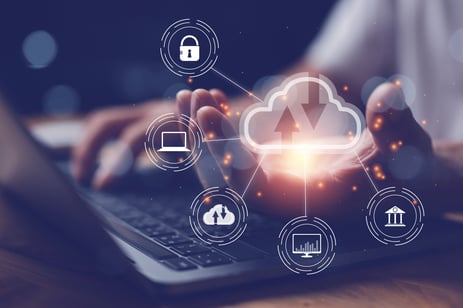What business goals will the upcoming technological developments address in the next year?
In the following three years, we anticipate that the 2023 trends will have an influence on business strategy by enabling firms to meet four crucial priorities:
1. Optimizing operations, trust, or resilience
2. Scaling up product supply, vertical solutions, or outsourcing
3. Innovative customer interaction, quick replies, and Lead Generation
4. Securing green technological solutions
Some services that will be on the rise:
- Digital Immune System
A solid digital immune system protects applications and services from anomalies, such as the impacts of software bugs or security issues, by making applications more resilient to recover rapidly from failures. It can reduce business continuity risks created when critical applications and services are highly compromised or stop working altogether. Enterprises face unprecedented challenges in ensuring resilient operating environments, accelerated digital delivery, and reliable end-user experience. The business expects to have the capacity to respond to market changes rapidly and innovate at a fast rate. End users hope for more than proper functionality — they want tall performance and their transactions and data to be secure and satisfactory interactions. A digital immune system combines practices and technologies from software design, development, automation, operations, and analytics to create a superior user experience (UX) and reduce system failures that impact business performance. A DIS protects applications and services to make them more resilient so that they recuperate quickly from losses. Focus on the optimization of the CX along with mitigating potential risks. Implementing a DIS requires an innovative mindset, but combining practices and technologies, ensures you'll keep complex digital systems running even when they are compromised.

- Applied Observability
As organizations launch new digital products and services, fine-grained visibility into item usage is essential for operational back and customer success, product management, and sales teams. Building observable systems help both business and IT stakeholders understand what features customers care about the most, what they struggle with, and how they can improve the service. Observability also offers a new approach to managing business change within organizations. Instead of monitoring business applications and processes, which are fundamentally reactive, observability relies on instrumenting methods with the necessary data and control mechanisms to enable proactive and preemptive actions. Applied Observability combines telemetry data obtained across multiple systems to make data-driven business and IT decisions. IT leaders must go beyond using observability for system reliability and construct an observable digital business.
- AI Trust, Risk and Security Management (AI TRISM)
The world of Artificial Intelligence is developing quickly as more people realize how powerful of a tool it can be. As technology expands, professions, use cases, and businesses emerge. Gartner Inc. is a well-respected technology research and consulting company that recently organized emerging AI-related technologies in "AI TRiSM" to provide a better understanding of the emerging AI ecosystem. AI TRiSM is shorthand for AI (T)rust, (Ri)sk, & (S) security (M)anagement. In the words of Gartner, AI TRiSM “ensures AI model governance, trustworthiness, fairness, reliability, viability, security and data protection. This includes solutions and techniques for model interpretability and explainability, AI data protection, model operations, and adversarial attack resistance.”
- Industry Cloud Platforms
Vertical cloud platforms combine software, medium, and infrastructure (IaaS) capabilities to provide particular solutions for different vertical industries. These industry solutions are primarily based on public cloud services but offer industry players a more agile way to manage workloads and accelerate change against their segment's business, data, compliance, or other needs. Industry cloud platforms will enable enterprises to quickly adapt their industrial processes and applications. As the Gartner 2022 CIO plan illustrates, composability is a vital enabler of higher performance and a better ability to cope with change. But this approach is also critical for the efficient creation of industry cloud platforms themselves. While in addition, a modular and composable system makes it easier for partners to deliver value-added capabilities through marketplaces and app stores. This extraordinary richness of industry cloud ecosystems, with multiple independent software vendors and system integrators joining the cloud providers, is a keyway that industry cloud platforms add value.

- Platform Engineering
Platform engineering is a process organizations can use to leverage their cloud platform as efficiently as possible so that engineers can deliver value to production quickly and reliably. In other words, we will say the platform engineering team serves the organization by planning, designing, and managing its cloud platforms. Such platforms can then be leveraged by software engineers and other IT professionals in the organization, allowing them to deploy and operate software in production in a safe, efficient, and reliable way. In numerous organizations, computer program engineers struggle with a few manual procedures to get their code to display. This includes manually making and configuring repositories, managing infrastructure components, and creating and managing CI/CD pipelines, from unit testing to production. Such procedures are often prone to error, which slows down the path to show. It's also common for many of those procedures to not be properly—or at all—documented, living entirely in the heads of critical employees. That makes for terrible communication as the organization grows, besides contributing to an awful bus factor. Platform engineering reduces those costs, removing the obstacles that slow developers down.
- Wireless-Value Realization
This integrates various wireless technologies, providing a more reliable, scalable, and cost-efficient technical foundation that reduces capital expenditure. According to Gartner, 50% of enterprise wireless endpoints will use networking services that convey additional capabilities beyond communication by 2025. This will be gone up from less than 15%. Wireless-value realization encapsulates everything from traditional end-user computing to digital tagging solutions and support for edge devices. Wireless is moving from a communications technology to a more comprehensive digital innovation platform.
- Super apps
Super apps give end-users a set of center features and access to autonomously made mini-apps. It’s essentially a platform used to deliver consistent and bespoke app experiences. Gartner said that by 2027, over 50% of the world’s population would be active clients of multiple super apps daily. Nifty apps are more than composite applications or portals that total features, functions, and administrations into a single user interface. An awesome app is the ultimate manifestation of a composable architecture and application.

- Adaptive AI
Due to the designing complexity and the demand for faster launch-to-market times, it is highly critical that fewer AI engineering pipelines or build AI models that can adapt themselves in production are developed. Adaptive AI systems allow the model’s behavior to adapt and change after it has been deployed by learning behavioral patterns from previous human and machine experience. This means it’ll be able to adapt faster to changing real-world circumstances.
- Metaverse
So, what is metaverse? It’s a combinatorial innovation that’s made up of multiple technology trends and themes. These trends are predicted to provide new challenges and opportunities to businesses across various industries. Metaverse tech allows people to replicate or enhance their real-world physical activities. This can happen in two ways: transporting or extending physical activities to a virtual world or transforming the physical one.
Whether you're looking for a specific innovative model to optimize your business or you need to implement a total digital transformation, at Allied Global Technology Services, we are continuously on top of the new technological trends that emerge. We offer different digital solutions for all types of businesses and can help you discover the one that best suits your needs. If you are ready to apply these services to your company, we are what you are looking for. You can get in touch with us at alliedITS.com and get more information.